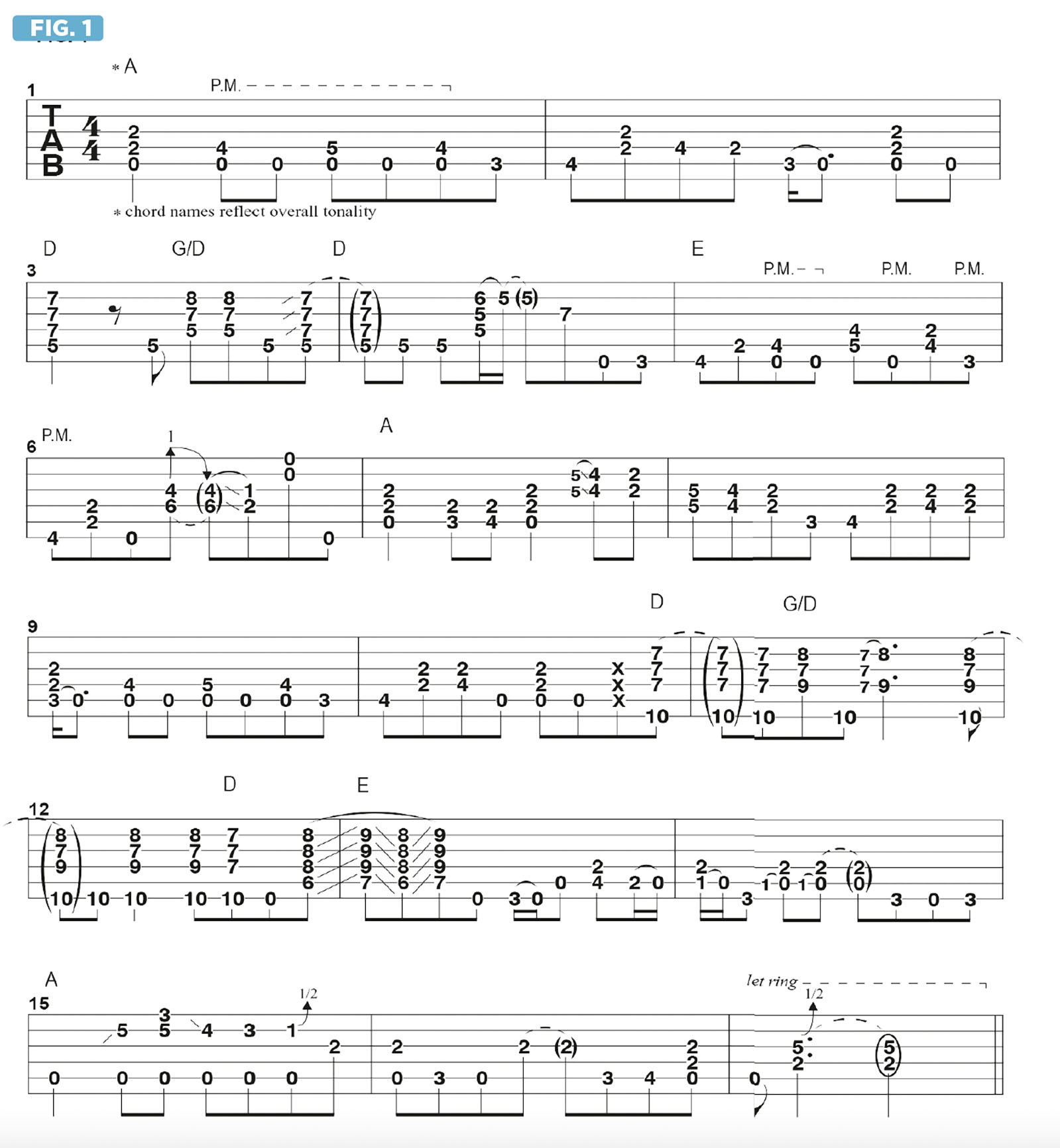
I’m not going to lie to you; I’m a big fan of rock ’n’ roll. I’m a huge fan of the Rolling Stones, and was very saddened to hear of the recent passing of their legendary drummer, Charlie Watts, who was one of the greatest rock drummers of all time.
As a young tyke, I used to play along to great live Rolling Stones records, such as Get Yer Ya-Ya’s Out! and Love You Live. I love the Faces, with the incredible Ronnie Wood and, of course, Rod Stewart. Oh, and I love Dave Edmunds. What I’m trying to say is, I like rock ’n’ roll.
For this month’s column, I thought it’d be fun and instructive to offer some examples of ways to embellish a little three-chord jam – think Let It Bleed – but in the key of A, based on the chords A, D and E. As I move through the repeating progression, I’m going to add “rando” rock filth to it, and then we’ll break it down so that you can add it to your own rock stew and serve it up piping hot to the kids.
Figure 1 presents a 16-bar rhythm guitar jam based on an eight-bar chord progression that’s played twice.
The progression starts with two bars on the tonic, or I (one) chord, A, followed by two bars of the IV (four) chord, D, two bars of the V (five) chord, E and then a return to two bars of the tonic. In this example, I play through the progression twice, with the second “chorus” beginning in bar 9.
Bar 1 begins with typical Chuck Berry-style rock ’n’ roll rhythm guitar, as I alternate between a root-5th A5 chord and a root-6th A6, or a root-flatted 7th A7(no3). At the end of bar 1, I offer a single-string melodic fill approach by utilizing the chromatically ascending notes C to C# (the minor 3rd to the major 3rd), followed by primarily single notes played on the D and A strings in bar 2.
In bar 3, I move to the IV chord, D, starting with a standard 5th-position D barre shape, which I embellish with a Keith Richards-approved G/D voicing on beat 3. Keith has made brilliant use of this move on countless Stones hits, from Brown Sugar to Start Me Up to Hand of Fate.
As you probably know, Keith has used open G tuning (low to high: D, G, D, G, B, D) on many of his songs, often with the 6th string removed, which facilitates this type of I-IV chord change in a way that couldn’t be easier for the fret hand.

Getting back to our example, the V chord, E, arrives in bar 5 and is introduced via chromatic movement on the 6th string, similar to what I did over the A chord in bar 2, now using the notes G and G#. Bar 6 includes a groovy technique on the upbeat of beat 2 into beat 3, as I play an oblique bend on the D and G strings.
An oblique bend is two or more notes played together, one of which is bent while the other(s) remain stationary. In this example, I bend the note on the G string up a whole step by pulling it in toward my palm, while also fretting an unbent note on the D string. After that, I release the bend and slide the two notes down to 1st position.
This brings us to the second eight-bar chorus over the progression, beginning in bar 9. As you play through the rest of the example, notice the slight variations in the single- and two-note licks, as well as the occasional three-note chord voicings. It may only be rock ’n’ roll, but there are an infinite number of ways to rock.
Get The Pick Newsletter
All the latest guitar news, interviews, lessons, reviews, deals and more, direct to your inbox!
Greg Koch is a large human who coaxes guitars into submission in a way that has left an indelible print on the psyches of many Earth dwellers. Visit GregKoch.com to check out his recordings, instructional materials, signature musical devices and colorful hats.
“There are so many sounds to be discovered when you get away from using a pick”: Jared James Nichols shows you how to add “snap, crackle and pop” to your playing with banjo rolls and string snaps
Don't let chord inversions bamboozle you. It's simply the case of shuffling the notes around








![Joe Bonamassa [left] wears a deep blue suit and polka-dotted shirt and plays his green refin Strat; the late Irish blues legend Rory Gallagher [right] screams and inflicts some punishment on his heavily worn number one Stratocaster.](https://cdn.mos.cms.futurecdn.net/cw28h7UBcTVfTLs7p7eiLe.jpg)


